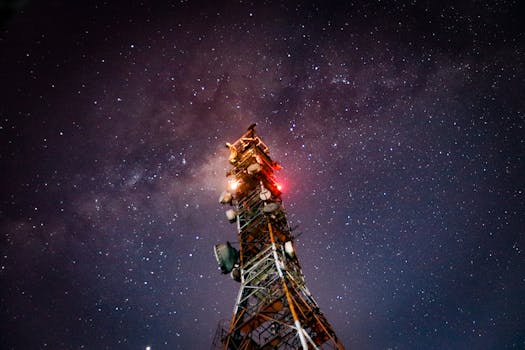
Starlink: Revolutionizing Global Internet Connectivity with Satellite Technology
Starlink is a groundbreaking satellite constellation developed by SpaceX, founded by Elon Musk, with the ambitious goal of providing high-speed, low-latency internet connectivity to the entire world. This innovative technology has the potential to bridge the digital divide, transform the way we communicate, and revolutionize various industries such as education, healthcare, and finance.
At the beginning of the Starlink project, the focus was on developing a constellation of low-Earth orbit (LEO) satellites that could provide fast and reliable internet connectivity to remote and underserved areas. The first batch of Starlink satellites was launched in May 2019, and since then, numerous launches have taken place, with the goal of deploying thousands of satellites in the coming years.
How Starlink Works
Starlink uses a constellation of LEO satellites, which are positioned at an altitude of approximately 550 kilometers above the Earth’s surface. These satellites are equipped with advanced technology, including Hall effect thrusters, star trackers, and high-gain antennas, allowing them to communicate with each other and with ground stations. The satellites are designed to provide internet connectivity to a network of user terminals, which can be installed in various locations, such as homes, schools, and businesses.
The Starlink system operates on the Ku and Ka frequency bands, which provide high-speed and low-latency connectivity. The satellites use a phased array antenna technology, which enables them to steer and shape the beam of radio signals, allowing for more efficient use of bandwidth and improved connectivity. The user terminals, also known as dish antennas, communicate with the satellites, transmitting and receiving data at speeds of up to 1 Gbps.
Benefits and Applications of Starlink
The benefits of Starlink are numerous and far-reaching. One of the most significant advantages is its ability to provide internet connectivity to remote and underserved areas, where traditional fiber-optic or cable infrastructure is lacking. This can help bridge the digital divide, enabling people in these areas to access essential services, such as education, healthcare, and banking.
Starlink also has the potential to transform various industries, such as aviation, maritime, and agriculture. For example, in-flight internet connectivity can be provided to airlines, allowing passengers to stay connected during flights. Similarly, ships at sea can access high-speed internet, enabling crew members to stay in touch with family and friends and access critical information.
Challenges and Future Developments
Despite the numerous benefits of Starlink, there are also challenges and concerns that need to be addressed. One of the main concerns is the potential for satellite congestion, as the number of satellites in LEO increases. This can lead to interference and reduced connectivity speeds. Additionally, there are concerns about the environmental impact of the satellites, as well as the potential for space debris.
SpaceX is continuously working to improve the Starlink technology, with plans to launch newer and more advanced satellites in the future. The company is also exploring new applications for the technology, such as providing internet connectivity to the Internet of Things (IoT) devices and supporting 5G networks.
As the Starlink constellation continues to grow, it is likely to have a significant impact on the global telecommunications industry. With its potential to provide high-speed, low-latency internet connectivity to anyone, anywhere in the world, Starlink is poised to revolutionize the way we communicate and access information.
As Starlink begins to roll out its services, it will be interesting to see how the technology evolves and how it will be received by the public. With its innovative approach to satellite technology and its ambitious goals, Starlink is certainly a project to watch in the coming years.
Starlink, and its parent company SpaceX, are pushing the boundaries of what is possible with satellite technology. As the world becomes increasingly dependent on internet connectivity, the importance of Starlink and its mission to provide global coverage cannot be overstated.
The development of Starlink has also sparked interest in the satellite industry as a whole, with many companies and organizations exploring the potential of satellite technology to provide global connectivity. As the demand for satellite-based internet continues to grow, it is likely that we will see significant advancements in the technology and its applications in the coming years.
With the launch of Starlink, the possibilities for global connectivity have expanded exponentially. Whether it’s providing internet access to rural communities, supporting emergency responders, or enabling global communication, Starlink is set to play a significant role in shaping the future of telecommunications.
The impact of Starlink on the environment is also a topic of discussion. As the number of satellites in orbit increases, there is a growing concern about the potential for space debris and the impact on the environment. However, SpaceX has implemented a number of measures to mitigate these risks, including the use of Hall effect thrusters, which are designed to minimize the amount of debris generated by the satellites.
As the Starlink constellation continues to expand, it will be interesting to see how the technology evolves and how it will be received by the public. With its innovative approach to satellite technology and its ambitious goals, Starlink is certainly a project to watch in the coming years.


